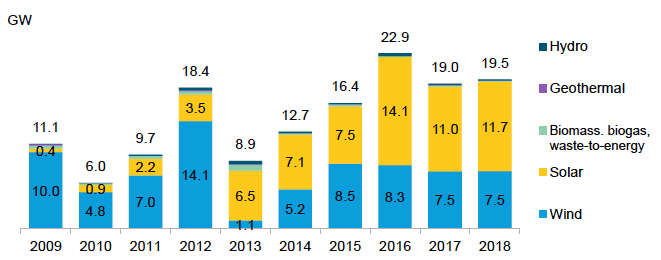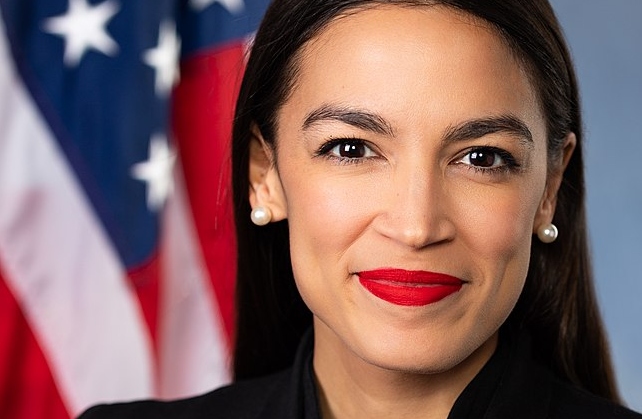From pv magazine USA.
Today the U.S. got its first real estimate of solar installations in 2018, with findings that indicated, despite four different rounds of tariffs – not to mention net metering and rate design battles and the gutting of the Public Utility Regulatory Policies Act at state level – solar installations grew 6% in 2018, to 11.7 GWdc.

Bloomberg New Energy Finance (BNEF) released the numbers as a data point in its Sustainable Energy in America Factbook, published in collaboration with the Business Council for Sustainable Energy. The report also examines the rise of natural gas capacity, and a 2.2% bump in emissions over 2017 levels, driven by more extreme weather and higher natural gas use.
The report’s executive summary provided more detail about solar, stating:
Continued uncertainty over solar and metals tariffs weighed on purchasing decisions in the first half of the year; meanwhile, developers are replenishing pipelines following 2016’s 14.1 GW and before the step-down of the federal investment tax credit.
The year-end recovery against those factors appeared to have caught BNEF by surprise. As recently as November, the company was predicting only 10.2 GWdc would have been installed last year – the numbers released today were 15% higher.
Shifting market drivers
What is clear is that 2018 was a year of change for U.S. solar. While the residential PV market stagnated year-over-year due to the end of net metering in several states and ongoing sluggishness in California, utility-scale drivers appear to be shifting.
In previous years, project contracts secured under the Public Utilities Regulatory Policies Act of 1978 (PURPA) were a growing driver of the large-scale solar market, but in 2018 those appear to have fallen away, with Wood Mackenzie Power & Renewables estimating only 300 MWdc of solar was installed under PURPA last year.
However, corporate solar procurement seems to be more than making up for the PURPA retreat. BNEF estimated large purchasers signed contracts for 8.6 GW of wind and solar in 2018, more than twice the previous record of 3.4 GW, contracted in 2015. The analyst went into particular detail on this point:
Procurement reached into new markets, as companies such as Facebook, Google and Walmart worked together with vertically integrated utilities in New Mexico, Georgia and Tennessee (among others) to build new wind and solar projects. New aggregation models also arose, allowing smaller energy buyers [such as] Etsy and Adobe to combine their demand [and] sign on to an individual project, thereby leveraging economies of scale previously only open to large consumers.
Battery installations grow
BNEF also reported 292 MW of battery storage was installed in 2018, much more than the 200 MW of average annual installations witnessed over the previous three years.
That capacity figure may hide a larger increase, as BNEF noted the average duration of the batteries installed doubled, to two hours from one, meaning around 600 MWh of batteries were installed. The analyst also noted the use case for batteries is getting broader.
Meanwhile, batteries are being deployed for a more diverse suite of applications, including for meeting resource adequacy requirements in California, pairing with solar and wind to help increase dispatchability in the Southwest and Hawaii, and offsetting demand charges on commercial and industrial power bills.
BNEF said the base of installed batteries is still much smaller than pumped hydro, which remains the largest source of energy storage in the U.S. And while there were no new pumped hydro projects, BNEF said as of October, applications had been filed with federal regulators for 2.3 GW of such facilities.
EV expansion
Finally, BNEF also said electric vehicle sales are growing, hitting 3% of total automobile sales in the fourth quarter, up from 1.3% in the final three months of 2017.
A fall in lithium-ion battery prices is behind both the growth in battery storage and EV deployment, which BNEF estimates fell 18% year-over-year. Another factor was Tesla’s Model 3 car hitting the market, becoming not only the top EV model but also the best-selling luxury car in the U.S. Overall, 138,000 Model 3s were sold last year.
For the first time, in 2018, EV sales exceeded hybrid figures, indicating the transition to pure electric transport may be developing faster than anticipated.
This content is protected by copyright and may not be reused. If you want to cooperate with us and would like to reuse some of our content, please contact: editors@pv-magazine.com.



3 comments
By submitting this form you agree to pv magazine using your data for the purposes of publishing your comment.
Your personal data will only be disclosed or otherwise transmitted to third parties for the purposes of spam filtering or if this is necessary for technical maintenance of the website. Any other transfer to third parties will not take place unless this is justified on the basis of applicable data protection regulations or if pv magazine is legally obliged to do so.
You may revoke this consent at any time with effect for the future, in which case your personal data will be deleted immediately. Otherwise, your data will be deleted if pv magazine has processed your request or the purpose of data storage is fulfilled.
Further information on data privacy can be found in our Data Protection Policy.